Departmental Newsletter Autumn 2018
Modern Earth Sciences is as dynamic and diverse as the planet itself. We study everything from the origin of the Earth to the history of the life it sustains. We are an integrative, interdisciplinary, modern science, applying state-of-the-art maths, physics, chemistry and biology in order to better understand the Earth and other bodies in the solar system.
The Student Experience: Field Geophysics
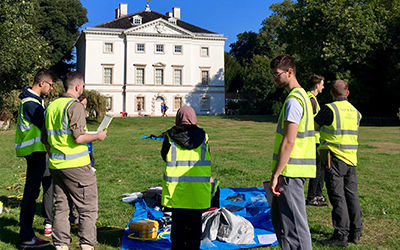

“A large part of the trip involved processing and interpreting the data, this allowed to deduce a number of features and hypothesise what we were seeing.
Meet the Staff: Dr Stephen Edwards
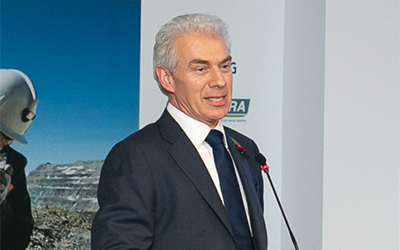

“My news is not about Paddington Bear in Peru, but rather tails or mine tailings in South America, where much of the world’s mining takes place.
Events: Torridonian Rocks in Scotland
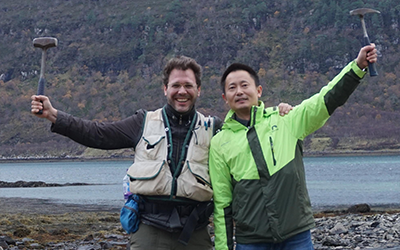

“It was a pleasant field trip without any bugs, great muddy treks, not too much rain, and beautiful seashore outcrops.
Research: Earth's Inner Core Observation
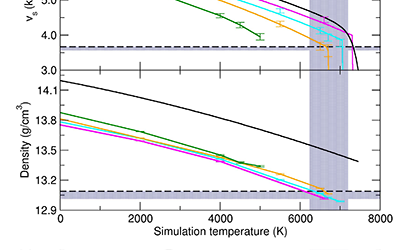

“Early in the Earth’s evolution, liquid iron together with light-element solutes gradually sank to the core through the magma ocean over millions of years.
Event: Professional Services Awards Ceremony
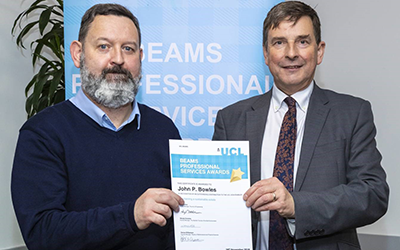
“John Bowles received a prize in recognition of his contributions to the UCL 2034 enabler ‘Maintaining a sustainable estate to meet our aspirations’.
Outreach: What if the Earth’s Core Went Cold?
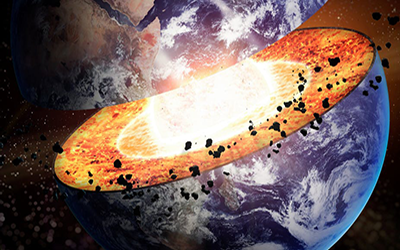
“One day, when the core has completely cooled and become solid, it will have a huge impact on the whole planet.
Impact: Hydrogeological research in SE Asia
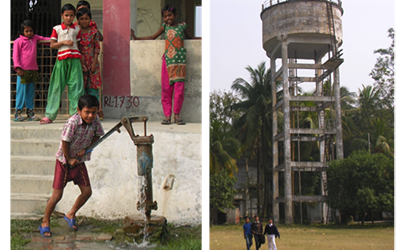
“The Impact Growth award aims to build resilient groundwater management strategies in SE Asia mega-delta regions.
Research Seminars: Global Geophysics (GoGo)
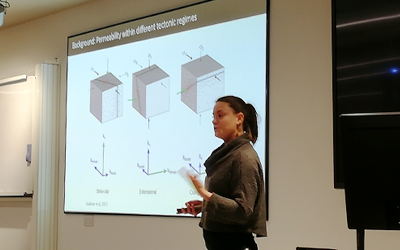
“Scintillating talks on all things geophysics with distinguished speakers from USA, UK scientists and our very own talented UCL staff & students.
Doctoral Studies: PhD Graduations

“Congratulations to our Year 2018 graduates. We celebrate their fantastic achievements and wish them all the best at the start of their professional future.
Update from Prof Paul Upchurch, Head of Department.
At present, anyone strolling along Gower Place might struggle to realise that the Department of Earth Sciences is still there – the Kathleen Lonsdale Building is covered in boards and scaffolding while its exterior stonework is cleaned. But on the inside, things are looking good. We’ve all been co-located in the KLB for the best part of ten months now and, despite one or two of the inevitable snagging issues that follow a major refurbishment, morale is high and feelings are positive. Aside from our new facilities, we’ve had various items of good news since my last update. For example, although we did not quite get enough returns to be able to use the result officially, I’m delighted to report that we achieved a 95% satisfaction rating in the most recent National Student Survey (second highest score for any department at UCL). Several members of staff have obtained major grants, and John Bowles (in charge of technical staff and Safety) has just been awarded a BEAMS professional Services prize for his contribution to the KLB refurbishment. And, after years of concern and waiting, the Bloomsbury Environmental Isotope Facility is moving to Earth Sciences and will have some of its key pieces of equipment upgraded.
One of the tasks we’ve been carrying out is to look at our papers since 2014 in order to identify those that we will submit for the next Research Excellence Framework. I mention this not to bore you with the technical details, but as a way of saying that I’ve recently had the opportunity to survey the research activity across the Department. This has involved reading the papers of colleagues who work in fields very different from my own, and it has ben fascinating and encouraging to see the shear diversity and high quality of the research carried out here. Topics include: monitoring current ice cover in polar regions; insights into the composition of the Earth’s core; the earliest evidence for life on Earth; driving forward policy change and public understanding on the climate change front; measuring and ameliorating the effects of ground-water pollution; improved understanding and mitigation of geophysical hazards; the impact of past climate change on the evolution of planktonic organisms; major environmental and ecosystem events preceding and during the Cambrian Explosion; and, dare I say slightly immodestly, a new dinosaur or two! So, if you do pass us by on Gower Place at the moment – remember, there’s a lot going on under all that scaffolding and boarding.
Coming of Age in a Hazardous World.
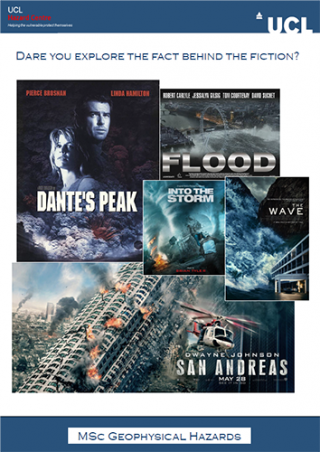
The dangers we are currently confronting range from tailings dams in the high Andes (see Steve Edwards' account in this newsletter's "Meet the Staff") to volcanic unrest outside the suburbs of Naples (see links below). These add to our existing portfolio of investigations into volcanic eruptions, landslides and hurricanes, all of which embrace the full spectrum from fundamental research to social application. Among our latest results are a new generation of interactive, web-based hazard maps, which Danielle Charlton is presenting this December at the AGU Fall Meeting in Washington DC.
The first 21 years are only the beginning. Earth Sciences are critical to the interdisciplinary studies the world needs to meet an uncertain future. The Hazard Centre has consolidated the Department's credentials on the international stage. Developing the credentials in the next 21 years will reinforce the Department's position in the vanguard of essential training and research. More News:
- UCL Hazard Centre at the forefront of preparing for volcanic eruptions, 2018
- When a volcano threatens: UCL pioneers new warnings of eruptions, 2018
Tom Forsey, 3rd Year Earth Sciences student
The Field Geophysics, field based course.
As part of my first term, I chose a module called Field Geophysics which comprised a five-day field course in Twickenham, South-West London. We were tasked with exploring the subsurface of Marble Hill Park using various geophysical methods. The park is an English Heritage site that surrounds Marble Hill House, a Palladian villa, originally built for King George II’s mistress. We used various geophysical techniques such as gravity strength, magnetic anomaly readings, electrical resistivity, ground penetrating radar and reflection seismology. The hands-on use of these unique scientific instruments furthered my interest in them and it was great to have experience using industry standard equipment. A highlight was using the gravimeter which is a mechanical instrument from the 1960s that uses a very sensitive spring and weight system and is capable of measuring up to 0.04mGal precision.
We hoped to build on previous historical knowledge that the site may contain buried gardens, a ninepin bowling alley, and two grottos. We chose our instruments to locate certain targets, for example, a buried grotto would be identified by taking a transect of gravity readings over the location of a known grotto and its void would show a dip in the strength of the gravity. We could then compare and model this signature to find other buried grottos in the grounds.
A large part of the trip involved processing and interpreting the data, this allowed to deduce a number of features and hypothesise what we were seeing. My specific question was looking at whether the terraces at Marble Hill House were man-made or natural. I chose to utilise the ground penetrating radar (GPR) and seismic techniques. The GPR was the most useful technique in investigating this question. Many features were clearly identifiable in the GPR data such as pipes which show up as hyperbole diffraction patterns. I hypothesised that the mid-terrace may also have been a man-made excavation, cutting down and adding the gardens at the artificial level as The geological boundary below the excavation seems largely unchanged which would suggest that the surface layer has been modified. The seismic survey provided useful data that can lead to inferences about subsurface properties such as increases velocities in the area where the gardens are believed to be which suggests denser material, perhaps gravel or stone.
I concluded that there was strong evidence to suggest the gardens were more extensive than the terraces suggest at present.
Tails in South America by Dr Stephen Edwards of the UCL Hazard Centre
My news is not about Paddington Bear in Peru, but rather tails or mine tailings in South America, where much of the world’s mining takes place. Mining and mineral processing leave a legacy of residues that must be carefully stored and managed. The most challenging of these are mine tailings, which are voluminous mixtures of finely ground rock and fluid from mineral processing. Throughout the world, tailings present a hazard owing to their locations and modes of storage, fluid content, mineralogical and chemical forms, and concentrations of potentially toxic and acid-generating species. Unfortunately there are many examples of tailings passively or catastrophically entering air, water, sediment and soil, and negatively impacting humans, the environment and ecosystem services.
Since 2012 I have led the RRAIMS (Reducción de Riesgos por Amenazas e Impactos Mineros en Sudamérica) initiative within the UCL Hazard Centre. RRAIMS uses integrated approaches and multi-stakeholder engagement to reduce risks associated with the combined effects of natural hazards and mining impacts. In so doing, the initiative has developed strong partnerships with government and non-government agencies, communities, businesses and industry in the UK, Bolivia, Brazil and Chile.
The main causes of tailings impoundment failures globally are extreme rainfall and flood, followed by structural and foundation conditions, earthquakes, poor management, seepage and overtopping. To date, the focus has been Chile, where most failures resulting from earthquakes. However, as extreme rainfall and flash flood events appear to be increasing, Chile is becoming increasingly concerned about these hazards causing tailings erosion or failure. In order to assist Chile address these hazard-tailings interactions, and after direct invitation from the Mining Minister of Chile in 2015 and funding from the UK Foreign & Commonwealth Office in 2016, I established the BRAHMIs (Building Resilience to Andean Hazards and Mining Impacts) programme within RRAIMS.
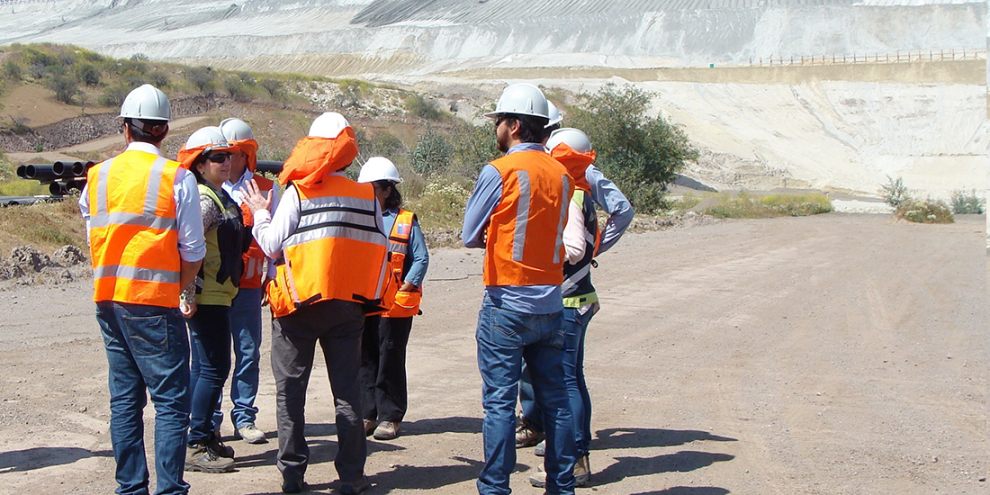
Within BRAHMIs, Adrian Chandler, Jonathan Mille and I have developed a model that generates earthquake-induced tailings failure scenarios. This research has now been extended to consider extreme rainfall and flood events through collaboration with the Sustainable Minerals Institute at the University of Queensland, Australia. These failure scenarios are coupled with hazard communication and visualisation techniques developed by other colleagues within the UCL Hazard Centre to convey information to decision makers and communities who need to implement risk reduction through land-use planning, early warning and evacuation, and socio-economic resilience. Engagement with communities living with the risk is of paramount importance and I am championing a new era of forward-looking tailings risk management, which is community focused within multi-stakeholder context. This approach has proven particularly successful in mining-affected communities on the Bolivian Altiplano.
RRAIMS may now be moving into Brazil. At the invitation of the Mining Sector of the UK Department for International Trade in Belo Horizonte, Brazil, I presented RRAIMS at the UK-Brazil Mining Forum in November. I also had the opportunity to visit the Germano plant operated by Samarco in Mariana on the third anniversary of one of Brazil’s worst environmental disasters, which resulted from the collapse of the Fundão tailings dam in November 2015. The week in Brazil reinforced the importance of RRAIMS and its potential application in this vast mining country.
For more information, please contact me at s.edwards@ucl.ac.uk
- Photo 1. Dr Stephen Edwards of the UCL Hazard Centre presenting at the UK-Brazil Mining Forum in Belo Horizonte, Brazil, on 08 November 2018.
- Photo 2. Tailings experts from Anglo American and the National Service of Geology and Mining of Chile at the base of the 90-m-high principal dam of the Las Tortolas tailings storage facility north of Santiago, Chile.
Torridonian Rocks in Scotland by Dr Dominic Papineau
During reading week, Dr. Dominic Papineau and visiting professor Zhenbing She (from the China University of Geoscience in Wuhan) visited the Torridonian Group of rocks in Scotland that date from the earliest part of the Neoproterozoic. It was a pleasant field trip without any bugs, great muddy treks, not too much rain, and beautiful seashore outcrops. We saw some great ellipsoidal to flattened concretions, text-book examples of cross-beds, microbial mats structures, and lots of sheep! Now that we are back at UCL we will look for microfossils in these rocks in the microscope to compare them with those we see in other phosphate-rich rocks.
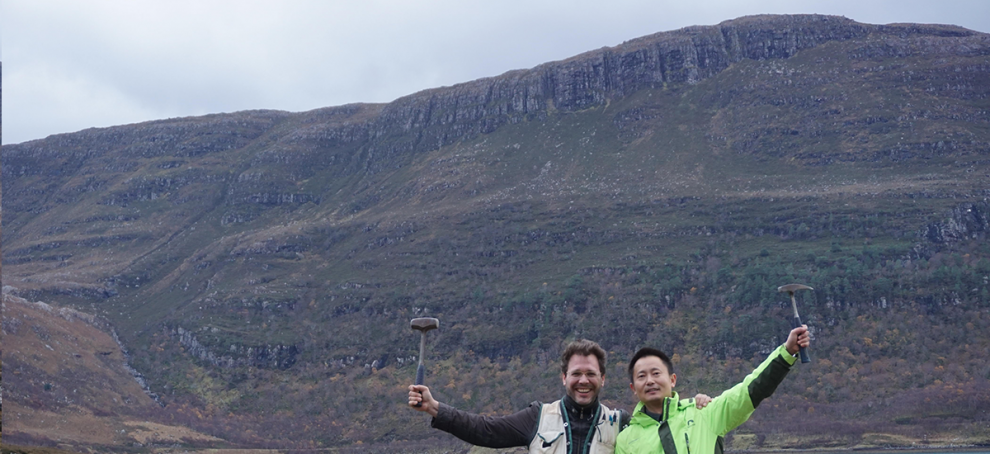
Dr. Papineau has been investigating Precambrian phosphorites since 2006 for their connection to atmospheric oxygenation and has been studying those from the Three Gorges Area in China and other phosphorite sites in South China, in collaboration with Prof. She. At CUG-Wuhan, Prof. She is now the Head of the Department of Mineralogy and Petrology, and he will be visiting our department until March 2019. Several of our recent joint publications on the Chinese phosphorites show that microfossils are very common in these rock types, and that they also commonly contain authigenic concretionary structures. We will soon discover how these formed...
Earth's inner core observation by Dr Yunguo Li
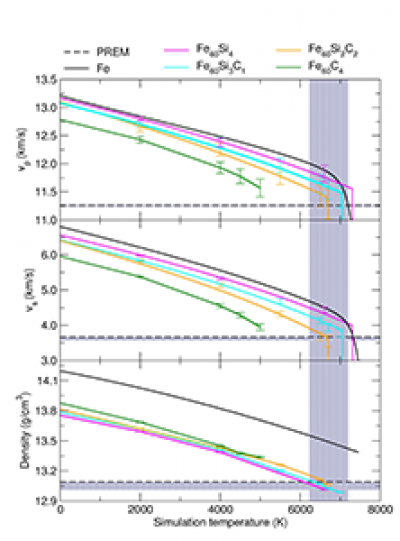
The proposed iron alloys and iron compounds turned out to have faster sound velocities than the seismic observation at the core density. This has motivated a number of suggestions of other mechanism to lower velocities, such as anelasticity or premelting (3). However, an unexplored possibility is that a combination several light-elements might produce the desired reduction in velocities and densities of the inner core. Using ab initio molecular dynamics calculations, we established a mixing solid solution model and mapped the elastic property space of hcp iron alloyed with silicon, sulfur and carbon at 360 GPa up to the melting temperature (4). For the first time, a number of ternary and quaternary candidates satisfying both the density and sound velocity constraints were found, where carbon is always a necessary component for the calculated sound velocities to agree with the observations. The small carbon atom can effectively lower the rigidity of the hcp iron lattice. We have not as yet tested oxygen or hydrogen, which is much smaller than C and may also mix to provide suitable solutions. Nevertheless, this work shows that a mixture of light elements can explain the properties of the inner core, without resorting to anelastic or premelting phenomena.
Figure Calculated sound velocities and density of hcp Fe-Si-C alloys as a function of simulation temperature at 360 GPa
1. K. Hirose et al., Crystallization of silicon dioxide and compositional evolution of the Earth’s core. Nature 543, 99-102 (2017).
2. A. B. Belonoshko et al., Stabilization of body-centred cubic iron under inner-core conditions. Nat. Geosci. 10, 312 (2017).
3. B. Martorell, L. Vočadlo, J. Brodholt, I. G. Wood, Strong premelting effect in the elastic properties of hcp-Fe under inner-core conditions. Science 342, 466--468 (2013).
4. Y. Li, L. Vočadlo, J. P. Brodholt, The elastic properties of hcp-Fe alloys under the conditions of the Earth's inner core. Earth Planet. Sci. Lett. 493, 118-127 (2018).
BEAMS Professional Services Awards Ceremony
John Bowles, our Departmental Estates Manager was the runner up for a BEAMS (The School of the Built Environment, Engineering and Mathematical and Physical Sciences) Professional Services Award. John received this prize in recognition of his contributions to the UCL 2034 enabler ‘Maintaining a sustainable estate to meet our aspirations’.
The judging panel concluded that the evidence submitted about John confirmed that John has gone beyond the expectations of his role, demonstrated significant initiative and made the most impact in enabling UCL 2034 in the area of maintaining a sustainable estate to meet our aspirations.
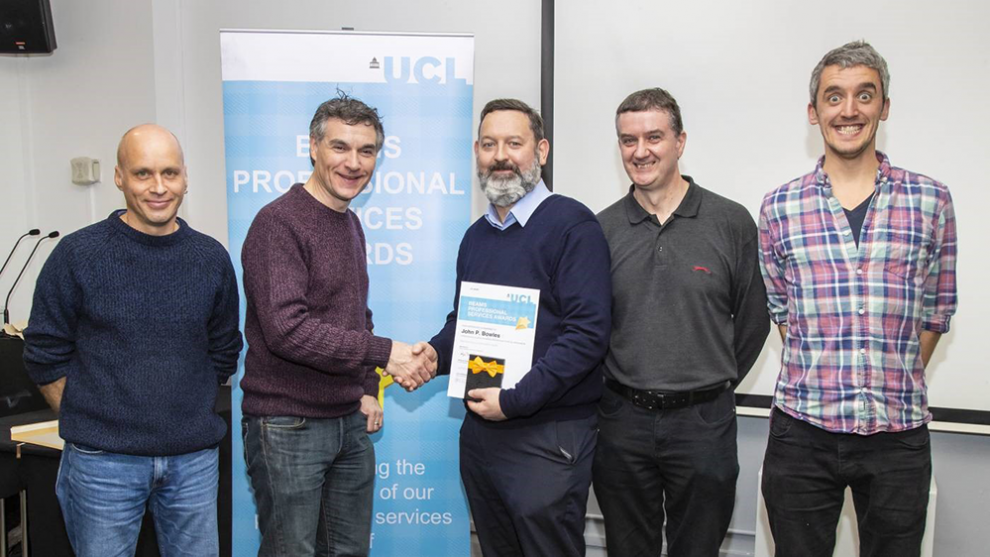
Outreach: Curious Kids: what would happen if the Earth’s core went cold?
Dr Paula Koelemeijer, our Royal Society Research Fellow writes in The Conversation, the independent source of news and views, sourced from the academic and research community and delivered direct to the public. Curious Kids is a series for children of all ages, where The Conversation asks experts to answer questions from kids. Paula, responded to Amelia, age 13 from Devon.
Thanks Amelia, that’s a very good question! The Earth’s core is cooling down very slowly over time. One day, when the core has completely cooled and become solid, it will have a huge impact on the whole planet. Scientists think that when that happens, Earth might be a bit like Mars, with a very thin atmosphere and no more volcanoes or earthquakes. Then it would be very difficult for life to survive – but that won’t be a problem for several billions of years.
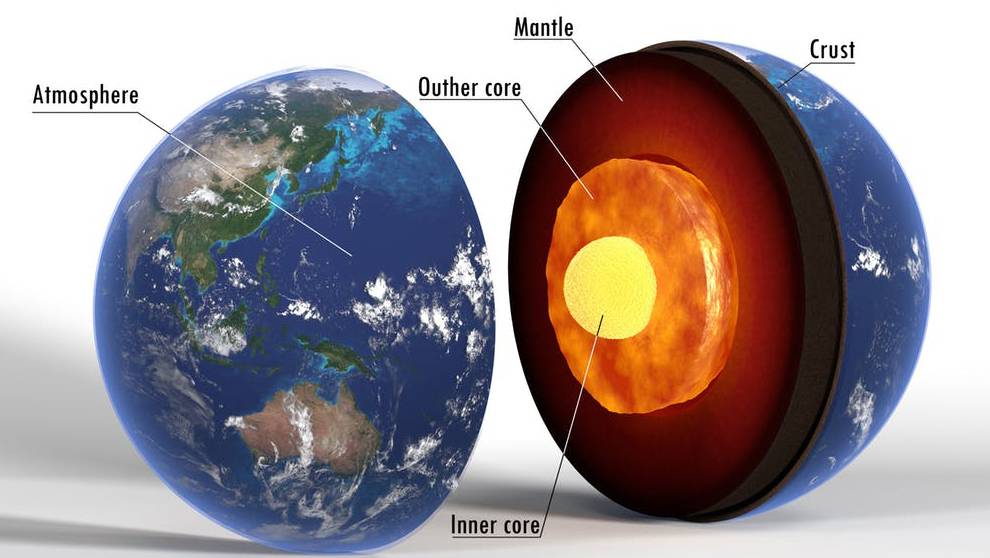
Right now, the Earth’s core is not entirely molten. The inner core is a sphere of solid iron, while the outer core is made of molten iron thousands of kilometres thick. Scientists know this because the shock waves made by earthquakes can be recorded on the other side of the Earth – and we would not expect to see them there if the inner core was also molten. The whole core was molten back when the Earth was first formed, about 4.5 billion years ago. Since then, the Earth has gradually been cooling down, losing its heat to space. As it cooled, the solid inner core formed, and it’s been growing in size ever since. But this process is very slow: the inner core only grows about one millimetre a year, because the Earth has a rocky mantle in between its hot core and its cold surface, which stops it from cooling down too quickly – just like your coat keeps you warm in winter. Read the full article.
Impact A new Impact Growth grant awarded to Prof William Burgess, to help hydrogeological research deliver public benefit in SE Asia.
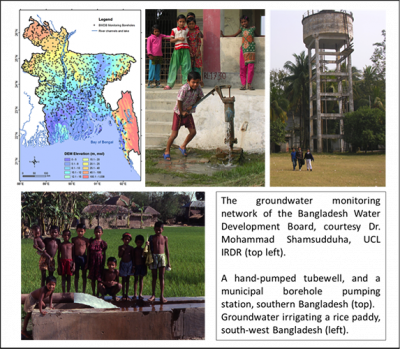
Traditionally, borehole water levels are taken as a measure of subsurface water volume, just as the level of water in a surface water reservoir rises and falls according to the volume of water stored. Our work has shown that this simple assumption is unreliable, and may be wrong at more than 75% of the sites being monitored by the responsible agencies in Bangladesh and Vietnam. Another process perturbs groundwater levels underlying the south-east Asian floodplains: mass loading of the ground surface during the monsoon stresses the young, elastically compressible sediments, increases the groundwater pressure and causes borehole water levels to rise, without any change in water volume. The analogy is a saturated sponge being compressed and water being squeezed out under the raised pressure. Subsequently, during the dry season, the floodplain sediments are relieved of a great mass of water at the surface, groundwater pressure eases and water levels in boreholes fall accordingly. The borehole water levels are acting as a spring balance, responding to changes in water mass at the Earth’s surface, not as a m
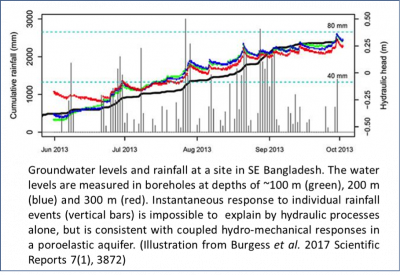
The award will cover the costs of a Seminar and Policy Workshop to be held here in the spring of 2019, ‘Groundwater in SE Asian mega-deltas: new insights and implications for policy and practice’, including travel and expenses for guests from Bangladesh, India and Vietnam, all influential in their national groundwater monitoring programmes. The award will also enable me to make follow-up briefing visits to policy officers in those countries. The Impact Growth award will therefore help deliver our new insights and their implications for procedure at policy level in government, to help the original UCL research lead to tangible public benefit.
Research Seminar series: Global Geophysics (GoGo)
UCL's Global Geophysics (GoGo) seminar series is back every Tuesday lunchtime for another year of scintillating talks on all things geophysics. This series has been a popular fixture within the Earth Sciences Department over the last 5+ years and this year the chairing baton has passed on to first year PhD students William Sturgeon & Kate Laxton and postdoctoral researcher Dr. Emmanuel David. And so far so good! We've had distinguished speakers from as far afield as the USA, as well as scientists working closer to home here in the UK and of course a bunch of our very own talented UCL staff and students.
Hot topics discussed by our visitors this term have included the use of ‘InSAR for earthquakes studies’ by Prof. Gareth Funning at University of California (Riverside), the ‘Geomechanical properties of the Groningen reservoir’ by PhD student Jonathan Smith (University of Cambridge), the ‘role of fluids on deformation processes’ by Prof. Greg Hirth (Brown University) and finally ‘the formation and evolution of asteroids’ by Dr. Ashley King at the Natural History Museum. Our departmental speakers have covered an array of geophysical curiosities such as the ‘Elastic properties of Iron’, ‘Seismo-geodetic modelling’, ‘Syn-kinematic epithermal gold deposits’, ‘Constraining mantle anisotropy, ‘Grain boundaries in the lower mantle’, and of course we learnt ‘why we should all learn Julia’.
Roughly half of our speakers so far have been from within the department, allowing fellow staff and students to learn more about research happening around them. This includes a number of PhD students and post-docs (Michael Freitsch, Ashley Stanton-Yonge, Jac van Driel, Martha Pamato), along with staff members Ana Ferreira and Nicolas Brantut, who attracted a huge 60+ crowd for his talk on programming with Julia.
Next term’s schedule is already filling up and promises to deliver a diverse range of exciting geophysical research, you can keep up to date with the schedule on our new webpage. We are fortunate to have been awarded a small grant for the seminar series, so if you would like to invite a speaker from the UK or abroad, then get in touch!
Doctoral Studies: PhD Graduations
We are pleased to announce that this year we have seen ten of our students successfully completing their PhDs. We celebrate their fantastic achievements and wish them all the best at the start of their professional future.
Jabraan Ahmed, our own undergraduate student obtained his MSci in Geology and his master project focused on the deep Earth and mineral physics. Jabraan’s interest in the energy sector and new emerging sources of fuel lead him to choose the topic of Shale Gas extraction for his graduate project: “Towards sustainable and risk free gas production from an unconventional source.”
Rehemat Bhatia, joined our Micropalaeontology research group to study tiny fossils with big stories to tell. Rehemat completed her undergraduate study in Geosciences at Royal Holloway, London. Her project focused on the geochemistry of planktonic foraminifera to study different palaeoceanographic conditions using trace element and δ13C multispecies analysis of Eocene and Oligocene age planktonic foraminifera to work out their palaeoecology, namely their depth habitats, photosymbiotic associations and ontogenetic changes.
Giulia Boucher, the alumni of King’s College (BSc in Physics) and Imperial College (MSc in Physics… joined our department for her PhD studies and earned the EngD degree in Earth Sciences, Molecular Modelling and Material Sciences. This was an EngD studentship offered under the Industry Doctorate Centre in Molecular Modelling & Materials Science run by Chemistry and under the supervision of Prof Dario Alfe. The main sponsor is EPSRC, and the industrial partner is AWE. Her PhD thesis title was “Melting curves of alkali metals from first principles calculations”.
Danielle Charlton, joined us after completing her Masters, Science of Natural Hazards at Bristol. Danielle’s thesis on “New approaches to volcanic hazard mapping at Campi Flegrei, Southern Italy” has developed innovative methodologies for designing and delivering hazard information to civil authorities and vulnerable communities. Her studies focused on the Campi Flegrei caldera, which has been in unrest since the 1950s for the first time in 400 years. Her results will be integrated into the emergency response strategies of the INGV-Vesuvius Observatory, which is the organization responsible for monitoring the active Neapolitan volcanoes of Campi Flegrei, Vesuvius and Ischia. In 2016 she was the winner of the award for the Best dynamic online map from North American Cartographic Society.
Matt Dodd, our joined PhD student with London Centre for Nanotechnology specialised in geochemistry, early life and astrobiology. He obtained his MSci Planetary Science at UCL. The overarching goal of Matt’s research was to trace the origin of organic matter as a possible biosignature of early life on Earth. His research resulted in a Nature publication: “Evidence for early life in Earth’s oldest hydrothermal vent precipitates. “ Listen to Matt and his supervisor Dr Dominic Papineau talk about their findings.
Michael Frietsch, joined us after completing his diploma degree in geophysics at KIT (Karlsruhe, Germany), He studies earthquakes with seismology and geodesy. Michel’s PhD research focused on determining the earthquake source mechanism and the analysis of the surrounding earth structure, deriving enhanced comprehension of earth's dynamics and its composition. Advanced knowledge about the earthquake source and high-resolution earth models may serve for example to make earthquake early warning systems more reliable.
Selina Groh started off as an ecologist in undergrad, then did a MA in evolutionary biology. Selina is a palaeontologist and his research focuses mainly on the evolution of Crocodylomorpha, specifically the 200 million year old crocodylomorph group of Neosuchia. He is working on reconstructing their ancestral relationships, the timing of when the different families arose and how they achieved their biogeographical distribution.
Chris Howard, obtained his undergraduate degree in Planetary Geology at UCL. His PhD project : “Properties of planetary ices formed in the NH3 – CO2 ± H2O ternary system” focused on both computation and experimental data, specifically to acquire thermal, structural, elastic and vibrational properties in preparation for a planetary model. Chris was part of the Crystallography and Mineral Physics research group.
David King, after graduating from University of Leicester with BSC in Geology joined us for his MSc in Geoscience here at UCL and continued with his PhD to study evolution on the microscale: "Evolution and extinction in the Miocene planktonic foraminiferal genus Paragloborotalia, and the importance of the Caribbean in planktonic foraminiferal taxonomy and biostratigraphy".
Alex Steely, received a BSc degree in Geology with Physical Geography from the University of Southampton, graduated from UCL earning a Distinction for his MSc degree in Geophysical Hazards. Alex continued with his graduate studies in our department and focused his PhD research on forecasting unrest and eruption at large volcanic calderas. His thesis, “The magmatic system of the Campi Flegrei caldera, in Southern Italy” was a joined project with Royal Holloway, London. Alex is co-author on number of studies in his field:
Resources:
Newsletters:
December 2017 | March 2018
Department history:
Geology at UCL - A brief history.
 Close
Close



